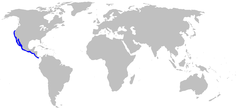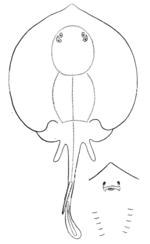Round stingray
- "Round stingray" may also refer to Taeniura grabata.
| Round stingray | |
|---|---|
 | |
| Urobatis halleri at the Frijoles dive site in Coiba National Park, Panama | |
| Scientific classification | |
| Kingdom: | Animalia |
| Phylum: | Chordata |
| Class: | Chondrichthyes |
| Order: | Myliobatiformes |
| Family: | Urotrygonidae |
| Genus: | Urobatis |
| Species: | U. halleri |
| Binomial name | |
| Urobatis halleri J. G. Cooper, 1863 | |
 | |
| Range of the round stingray | |
| Synonyms | |
|
Urolophus halleri Cooper, 1863 | |
Urobatis halleri also known as the Round stingray or Haller's round ray is a species of round ray, family Urotrygonidae, found in the coastal waters of the eastern Pacific Ocean. It is a small, common ray that feeds mostly on benthic invertebrates. On the beaches of southern California, it is responsible for numerous injuries to bathers, who are stung when they accidentally step on the fish. The wound caused by its venomous spine can be painful, but is non-fatal.
Taxonomy

The round stingray was originally assigned to the genus Urolophus, until Garman (1913) moved it into his newly erected genus Urobatis. The species name, halleri, is after the young son of Major Granville O. Haller of the United States Army, who was stung on the foot while wading along the shores of San Diego Bay.[2] This species is placed in the genus Urobatis.[3]
Distribution and habitat
This species is endemic to the eastern North Pacific Ocean, from Humboldt Bay in northern California south to Panama. It is most common around southern California and the Baja Peninsula. They inhabit tropical to warm-temperate waters close to shore, usually less than 15 m deep, although they have been reported to a depth of at least 91 m. This species favors soft-bottomed habitats such as mud or sand, often with abundant eelgrass, which they use for camouflage.[2][4] They also occur around rocky reefs.[4]
Round stingrays prefer temperatures above 10 °C (50 °F); the adults are more tolerant of temperature changes than juveniles. They are most abundant in the coastal and bay waters of southern California from spring to fall. In winter, they move to deeper water where the temperature is more stable.[2] Round stingrays have been observed congregating near the warm seawater effluent released by coastal electric generators, which may replicate the conditions of estuary environments.[5]
Description
The round stingray has a nearly round pectoral fin disc usually colored brown or grayish brown above, with pale yellow spots or reticulations. Some individuals are plain or black. The underside is white to yellowish. The tail is short and stout, with a long, thick, serrated stinging spine. The teeth are small and diamond-shaped, and sexually dimorphic in that the central teeth of males are erect, sharply pointed, and curved inward. They attain a maximum pectoral fin disc width of 25 cm in males and 31 cm in females.[2]
The tail spine is periodically shed and replaced; for most of the year round stingrays have only one spine, but at the beginning of July small secondary spines begin to appear. The number of rays with secondary spines increases to a peak around September and October, then declines as the primary spines fall off and are replaced. The replacement process is complete by December.[6]
Biology and ecology
In nature, round stingrays strongly segregate by age and sex, with the females staying in water deeper than 14 m and males and juveniles in shallower habitat. The juveniles feed on polychaete worms and small benthic crabs until they are 14 cm across. As they mature, their diet shifts towards bivalve molluscs and polychaete worms with crabs becoming less important, serving to reduce competition between adults and juveniles. Round stingrays are daytime foragers that are most active in the warm temperatures of summer and fall. Using their pectoral disc and mouths, they dig large pits to uncover buried prey. The digging of these pits plays an ecologically important role, as they also uncover prey for smaller fish.[2]
In the northern part of its range, round stingrays are preyed upon by the northern elephant seal and the black sea bass. Other predators include large sharks. Numerous parasites are known for the round stingray, comprising 40 species in approximately 19 families. External parasites include copepods and leeches, while 16 species of tapeworms are known from its digestive system, including Phyllobothrium hallericola n. sp. and Acanthobothrium olseni. Additional parasites that may be found in this ray's spiral valve intestine include Eimeria chollaensis sp. nov. and Rhinebothrium spp.[7]
As with other stingrays, the round stingray is ovoviviparous, bearing litters of 1-6 young with an average of 2-3. The litter size increases with female size. The gestation period is three months, with the young measuring 6–8 cm across at birth. The females able to store sperm year-round. In southern California, the females move inshore to mate from April to June, with the young being born between June and October. Further south in the Gulf of California, females mate and give birth earlier, from late winter to spring. A portion of the population mate and give birth in winter, allowing for a second breeding season later that same year. After giving birth, the adult females move back into deeper water while the young remain in the shallows.[2] Female round stingrays emit a localized positive electric field from near the spiracles behind each eye, which serves to attract males. The males will bite at the area, with successful contact necessary for copulation.[7] Round stingrays grow at 3 cm per year until they reach maturity at around 31 months, at which time their growth rate slows.[2]
Relationship to humans

Every year, hundreds of beachgoers are accidentally stung by round stingrays along the coast of southern California. The sting is not fatal, though it is quite painful. The so-called "Ray Bay" at the northern end of Seal Beach, used as a nursery ground by round stingrays, is the most notorious location for these incidents. At least 474 people were stung at that beach between April and November 1952, and over 500 people were stung over a ten-week period in 1962. During the 1990s, an average of 226 bathers were stung per year on Seal Beach, with the number of incidents rising during warmer El Niño years.[2] Recently, local authorities and scientists have begun tagging the stingrays and clipping their spines in an effort to reduce the number of injuries. However, there is little evidence that this program has been successful, likely due to the large population of the rays, their itinerant nature around the region, and their annual spine replacement.[6]
Due to its small size and large tail spine, the round stingray is considered commercially undesirable. It is occasionally caught (and discarded) by recreational anglers and artisanal gillnet fisheries. In Mexico, the tail is usually cleaved off before the ray is discarded, likely causing high mortality.[1] This species is also taken as bycatch by shrimp trawlers, who consider them a nuisance as large groups often become entangled in the nets.[2] Due to its abundance and relatively high rate of reproduction, the round stingray is assessed as of Least Concern on the IUCN Red List.[1] It is docile and easily approached by divers, and adapts readily to display in public aquaria.[7]
References
- 1 2 3 Ebert, D.A. (2005). "Urobatis halleri". IUCN Red List of Threatened Species. Version 2008. International Union for Conservation of Nature. Retrieved 2008. Check date values in:
|access-date=(help) - 1 2 3 4 5 6 7 8 9 Ebert, D.A. (2003). Sharks, Rays, and Chimaeras of California. London: University of California Press. ISBN 0-520-23484-7.
- ↑ Moral-Flores, L.F.D.; Angulo, A.; López, M.I. & Bussing, W.A. (2015). "A new species of Urobatis (Myliobatiformes: Urotrygonidae) from the tropical Eastern Pacific". Revista de Biologia Tropical. 63 (2): 501–514. doi:10.15517/rbt.v63i2.15746.
- 1 2 Froese, Rainer and Pauly, Daniel, eds. (2015). "Urolophus halleri" in FishBase. February 2015 version.
- ↑ Hoisington, G. (IV) & Lowe, C.G. (2005). "Abundance and distribution of the round stingray, Urobatis halleri, near a heated effluent outfall". Marine Environmental Research. 60 (4): 437–453. doi:10.1016/j.marenvres.2005.01.003.
- 1 2 Lowe, C.G.; Moss, G.J.; Hoisington, G. (IV); Vaudo, J.J.; Cartamil, D.P.; Marcotte, M.M. & Papastamatiou, Y.P. (2007). "Caudal Spine Shedding Periodicity and Site Fidelity of Round Stingrays, Urobatis halleri (Cooper), at Seal Beach, California: Implications for Stingray-related Injury Management". Bulletin - Southern California Academy of Sciences. 206 (1): 16–26.
- 1 2 3 Bester, C. (2008): Biological Profiles: Round Stingray. Florida Museum of Natural History Ichthyology Department.
